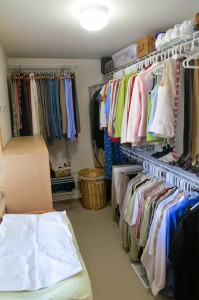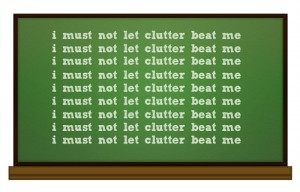My husband Bob and I had an experience that transformed our ability to de-clutter our home effectively. We have always been strong advocates of trying to clean out things we no longer need, especially since we’ve always lived in small homes and we’ve desired all the space we could get. But when we put our house on the market for sale a few years ago, we became what we thought were temporary extreme de-clutterers (yes, I made up that word) through the use of a rental storage unit; but this actually transformed us into master de-clutterers! *chuckle* Our home needed to look and be more spacious. And by de-cluttering, well, one can literally double the amount of space in a home. You’ll have more space for the children to play in, more space for homeschooling, more space for relaxation, more space for company, more space for more children – more space to live in! I’d like to share the following with you:
[bullet_list icon=”check”]- Strategies and methods for de-cluttering
- How to be careful with others in your family as you develop plans for de-cluttering and organizing your home
Strategies & Methods for De-cluttering
Probably the biggest reason it’s so hard for people to stay organized, is that they have too much stuff. People can spend enormous amounts of time managing stuff, which is overflowing and therefore can’t stay organized. People then feel that their efforts are fruitless and pointless and they stop trying, or acquire great stress trying to keep up with it all, which affects something of far greater importance – relationships.
When we were preparing to put our house on the market for sale, it was far easier for me to de-clutter when we thought we were taking things out temporarily. We were putting things into boxes to go to storage, rather than getting rid of things permanently. This made a huge difference in how willing we were to let go of things because we didn’t think it wasn’t going to be permanent. Here’s what we did. We put away:
[bullet_list icon=”check”]- Everything that I wasn’t going to use within the next 6-8 months, and things that weren’t really necessary to have out (nick-knacks)
- Bed & bath linens that were extras
- Kitchen items that were extras and duplicates (i.e. Tupperware, cookware, counter-top appliances, plastic sippy-cups…)
- Decorations that sat around collecting dust or that cluttered up walls and floors (except for my very favorite things).
- Books we hadn’t read in the last year, and that we never actually referenced or re-read as intended.
- Furniture that I liked, and hoped to have a better place for in a different house some day, but didn’t have room for now.
- Clothes, shoes & coats I never actually wore no matter how nice they were (again, I only wore my very favorites).
- Toys that weren’t played with much.
- Everything that was stored behind doors or underneath furniture (unless it’s organized that way, for example we keep all of our gift wrapping supplies under our bed in a box, and some seasonal clothes in boxes, too).
- We had been wanting to not have a TV in our home any longer (watch for a future post on why we choose to not own a TV), this was the perfect opportunity to sell the huge entertainment center that took up a lot of space
Here are some de-cluttering principles to keep in mind:
[bullet_list icon=”check”]- We personally don’t let the kids keep “garbage” to play with (toilet paper roles, food containers, cardboard boxes), as we just don’t have space for them in our small house.
- We also now keep a cardboard file box, marked “Value Village”, in our garage to put items in to when they need to be given away. When I come across that clothing item that no one wears, and stuffed animals that are always over flowing on to the floor and no one uses – items to be given away – they need a ‘home’, too.
- Before buying an item decide where it’s ‘home’ will be. Sometimes in order to bring more in to our home we need to take something else out to make room.
- Don’t be afraid to throw things away! Pitch it, toss it, get rid of it and free yourself from being buried by it! Don’t let your stuff manage you.
- For us, piles equal disorder and clutter.
- This may sound cold, but I would encourage you not to keep an item just because it was a gift to you If you absolutely love it, and it has a ‘home’, keep it – otherwise don’t. You’ll just have to manage it.
If items don’t fit in to our home in an orderly way, then they don’t fit in to our home. - We began thinking to ourselves, If we haven’t worn it or used it within the last year then it goes. This turned out to be an excellent way to determine what to keep or not; and we never regretted that cut-and-dry decision making plan. It helped us make quick decisions about just about everything.
- It’s a good plan to de-clutter a space, wait 30 days, then go back to that area and re-evaluate things you kept and de-clutter again.
After our massive de-cluttering project we looked around our house and said, “Heeeyyy…this feels SO GOOD.” The floors looked clean because there was no stuff underneath furniture or shoved in to corners. There was nothing propped up behind doors. We had lots of open wall space, revealing a nice wall color that is attractive and soothing. Linens in the linen closet were in smaller, straight piles because the piles weren’t so high that to remove any item caused t
How to be careful with others in your family as you develop plans for de-cluttering your home
First, let me say that it’s important to get “buy in” from your husband before you start de-cluttering (more on this below). Next, I encourage you to start with one, small room or space, and one that is primarily “yours.” If you start with one of these personal areas you’re also likely to not have others in the family adding to the space you’re trying to clean out. You’ll have a sense of accomplishment and a success to enjoy.
Also consider who has had dominion over the space you’re thinking of de-cluttering. It’s almost always easier to look at other people’s stuff first, before your own, and get aggressive with getting rid of things. But consider, has the garage been your husband’s space? Has a child’s bedroom been their own space, to be done with as they please as long as the door is closed? How will your spouse or your son or daughter react to your becoming a whirlwind and changing everything in “their” space one afternoon without consulting them? (Not that you ask your children for permission to organize your home, but I think it’s good that they be included in decisions when they’re old enough to do so, especially when that’s been the understanding thus far.) There also needs to be submission to a husband’s desires for the home. If he likes things the way they are but it is disorderly and cluttered, try agreeing on a direction towards more order; you could ask about compromise. If the garage has been “his space”, consider dividing it in to two parts. Leave his stuff as it is if he’d like, and ask if you may clean out the other area(s). It’s important to get “buy-in” by those other family members when appropriate. You could give a time frame within which changes could be made. You could invite them to watch what you do in “your” space (that which you’ve had sole dominion over, perhaps your desk, or your closet) and then invite them to join in with the new de-cluttering and organizational plans for other spaces. But take responsibility for your own space first. You can testify as to what and why you’re changing things, and then let them see the “fruit”! *smile* Also, training children to keep things in order and put things away really needs to begin after you’ve de-cluttered. They can’t be expected to put things away if there is no known and established ‘home’ for those items.
I hope you have caught a vision for de-cluttering at home if you need to. I would love to hear about your de-cluttering or organizational adventures! Blessings on your efforts!
 Erika Shupe
Erika Shupe
Erika has been married to her wonderful husband, Bob, for 16 years; together, they co-author Large Families on Purpose. They live with their nine children in the beautiful Skagit Valley of WA where they enjoy homeschooling, boating on the Puget Sound, and the simple things in life. Erika aspires to bring hope, vision, and encouragement to those around her.
Read the full, unabridged article on “De-cluttering: The First Steps to Organization” here!
“clutter,” © 2009 Sean MacEntee. Used under a Creative Commons Attribution-Noncommercial license: http://creativecommons.org/licenses/by-nc/3.0/.



